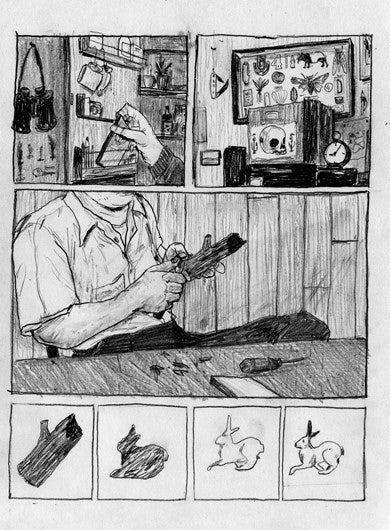Treehouse
The (tree)house can be a safe nest, located far from other people. It’s a place to come to yourself, surrounded by wild animals and thriving flora. This space was very important to Ward. The treehouse theme linked his love of nature and his tendency to hide. The cave and the burrow are recurring variations on this motif. His studio had the same function. By surrounding himself with objects, cut-out photos, drawings and music, he created a very personal spot in which he could concentrate on his creative output. In an era in which human beings distance themselves ever further from nature, Ward was interested in people who withdraw into the forest to escape from society (see: Outsiders, Forest).

For 'Camp Out' (77), Ward exhibited a typecase of little drawings on the theme of outdoor survival. He later collected this series into the booklet 'Fox Fox' (78). He also illustrated an untitled short story which was subsequently expanded with various pages and separately published as the zine 'Wolf' (79). The main character observes the forest from his fully furnished treehouse, a creative refuge resembling the idea of the studio mentioned above. Ward found inspiration for this project in the socially critical novel 'Walden; or, Life in the Woods' (80). This book had a lasting impact on his life and work (see: Bukowski & Co).
The treehouse turns up again in the zine 'Donderdag 26 mei' (‘Thursday May 26th’) (81), in which Ward describes meeting a girl who lives in a treehouse. This story was also published in 'Mostly Cola' (82) and 'Astral Talk' (83) under the title 'Laura'. For a group exhibition (84), Haas & Gaai (‘Hare & Jay’) constructed an art installation in a gallery (see: Haas & Gaai). The theme of the exhibition was ‘utopia’. The duo decided to create an ode to failure. According to them, being able to fail as an artist represented ultimate freedom. In the central space, which they had strewn with litter and failed works of art, Haas & Gaai built a stilt hut. Visitors could climb a small ladder to look inside, where, next to a crying hare and a snoring jay, various artefacts from the artists’ studio were on show.
- (77) Camp Out — group exhibition and publication by Ward Zwart, Ephameron and Louis Reith, both with the same title. Alley Gallery: Hasselt, 2010. Self-published: Antwerp, 2010, 300 copies, technique: photocopy with screen-printed foldout cover, 2 colours on light-blue paper.
- (78) Fox Fox — Ward Zwart. Self-published: Antwerp, circa 2010, number of copies unknown, technique: photocopy.
- (79) Wolf — Ward Zwart. Self-published: Antwerp, 2011, 100 copies, technique: risograph, 2 colours, extra flap with logo around the cover.
- (80) Walden; or, Life in the Woods — Henry David Thoreau. Ticknor and Fields: Boston, 1854.
- (81) Donderdag 26 mei (‘Thursday 26 May’) — Ward Zwart. Self-published: Antwerp, 2011, 24 copies, technique: photocopy.
- (82) Mostly Cola — Ward Zwart. Anthology of short stories written in 2010 and 2011. Self-published: Antwerp, 500 copies, offset in two spot colours, foldout dust jacket.
- (83) Astral Talk — ed. Aidan Koch. Publication Studio / Jank Editions: Portland, 2011.
- (84) Graphic A.N.D.: A Framed Utopia — group exhibition. Electron: Breda, 2013.